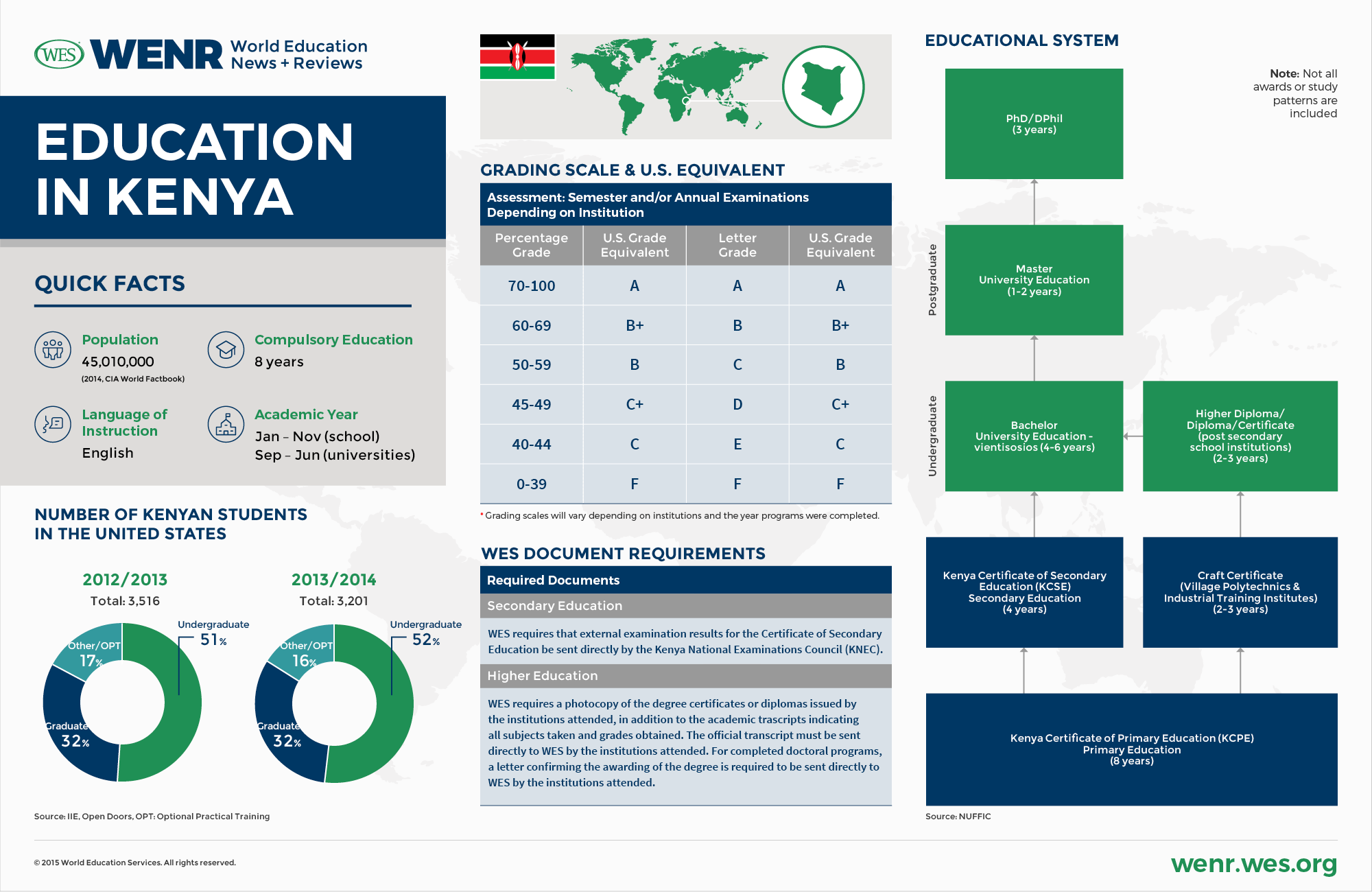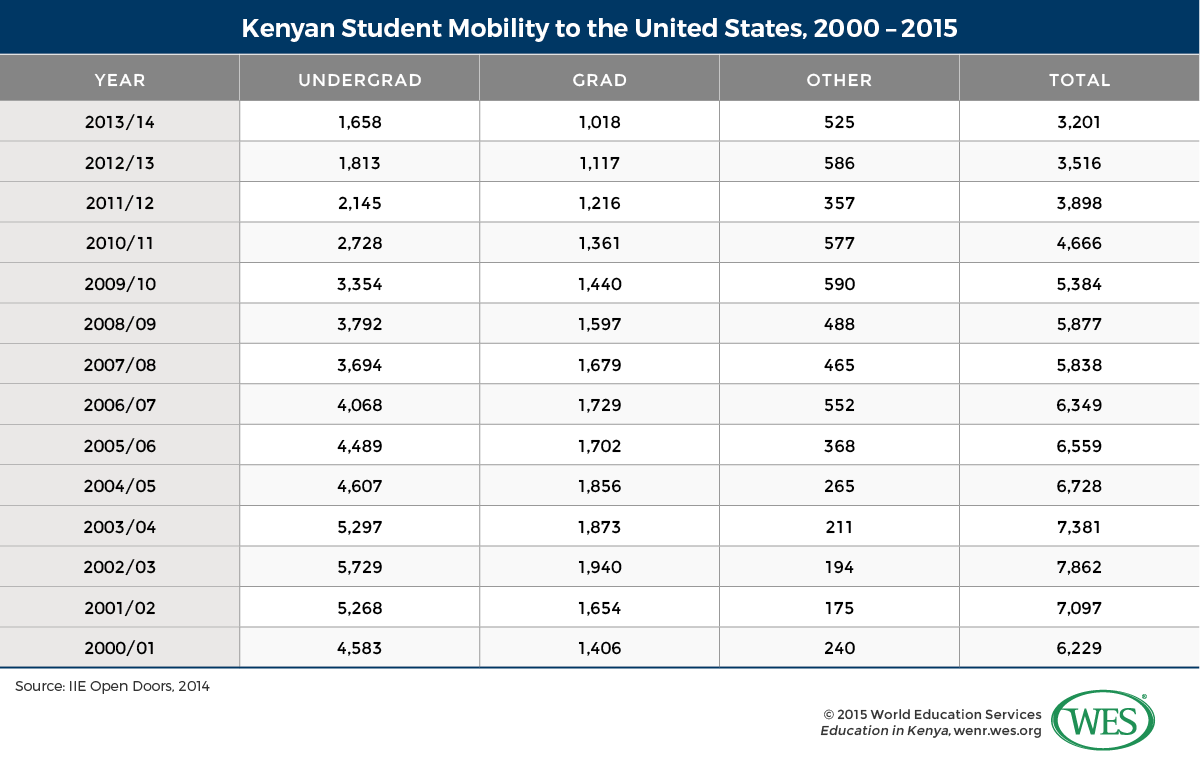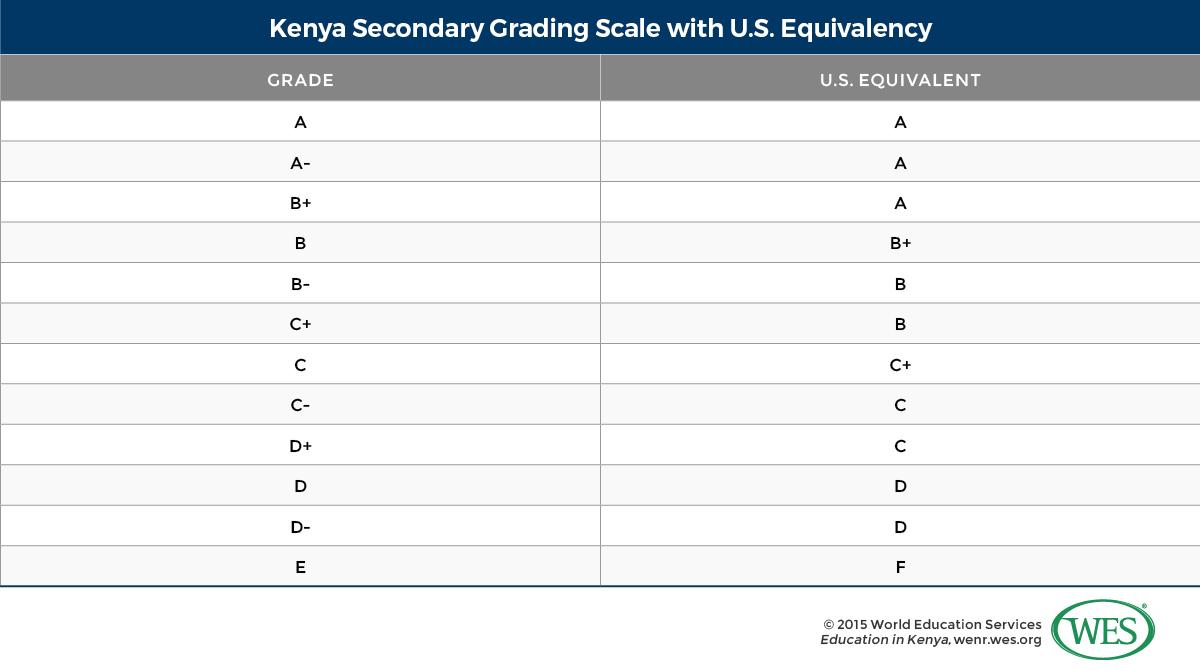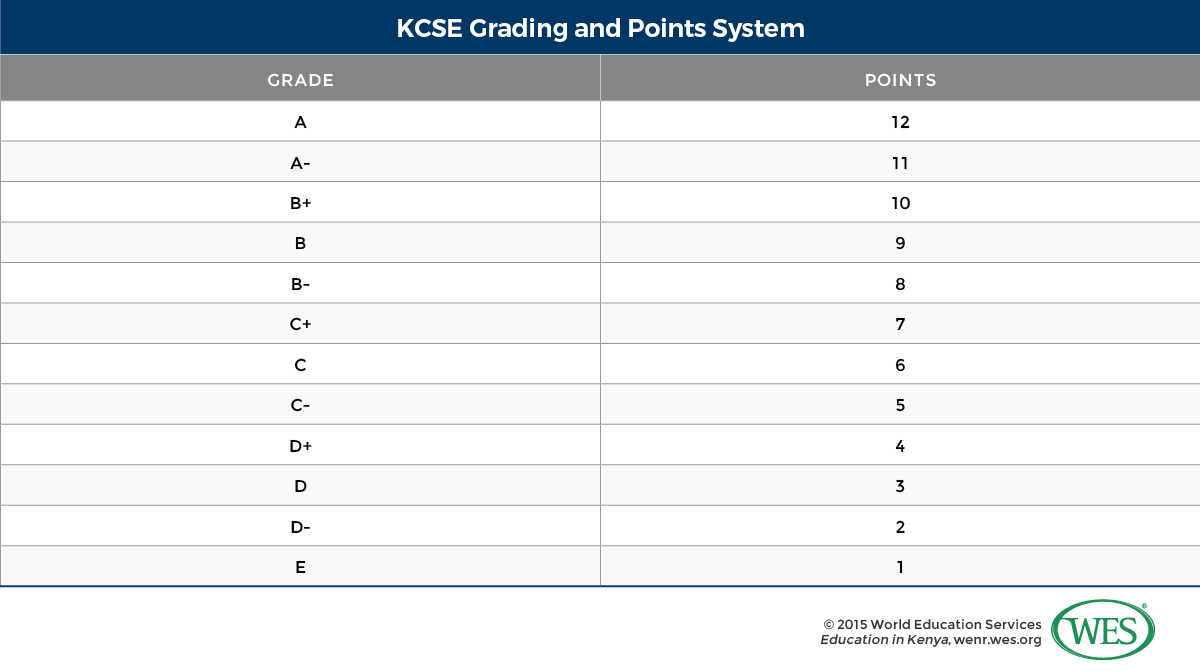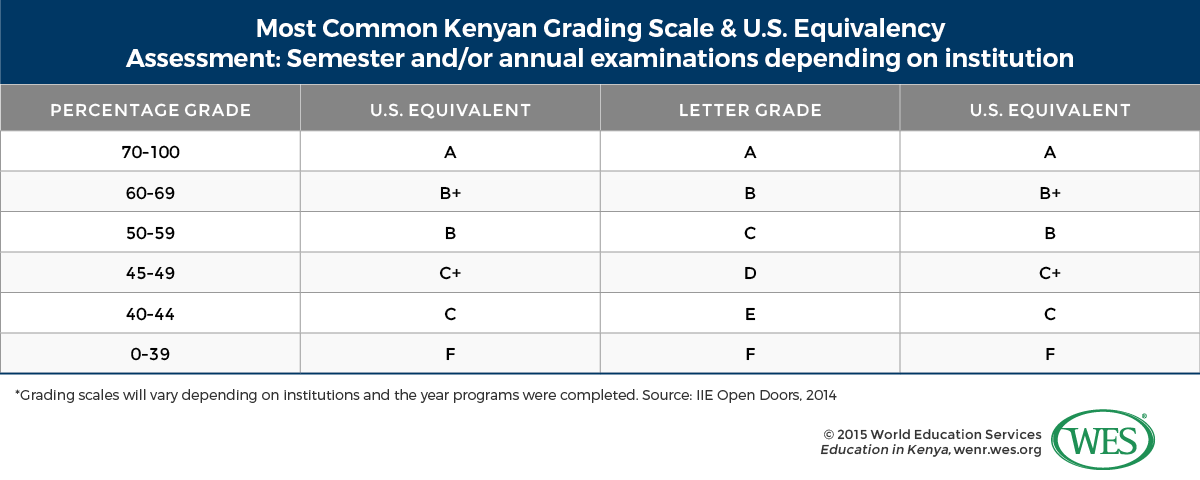By Nick Clark, Editor, World Education News & Reviews
In 2003, the government of Kenya instituted a free primary education for all program, and then did the same for secondary education in 2008. As a result, nearly three million more students were enrolled in primary school in 2012 than in 2003 and the number of schools has grown by 7,000. Between 2003 and 2012, the secondary gross enrollment ratio increased from 43 percent to 67 percent, as graduates from the new free primary program moved their way through the system. More recently, the impact of the 2003 education for all program has been seen at the university level, where enrollment numbers have skyrocketed, more than doubling between 2012 and 2014 as the initial cohort of free primary school children have begun enrolling in university studies.
Nonetheless, much progress in educational quality and access remains to be made in Kenya. In 2010, one million children were still out of school, and while this was almost half the number in 1999, it is still the ninth highest of any country in the world. Issues related to educational quality persist, especially at the primary level, with illiteracy rates increasing among students with six years of primary schooling. Over a quarter of young people have less than a lower secondary education and one in ten did not complete primary school.
At the university level, student numbers grew by a massive 28 percent between 2013 and 2014, and similar growth is expected this year, yet funding was cut by 6 percent in the 2015 national budget. The mismatch between funding and enrollment growth will mean a heavier tuition burden for students, increasing the significant access issues that already exist for the marginalized, and adding to quality issues related to overcrowding, overburdened infrastructure, and faculty shortages.
International Mobility
According to UNESCO data, there were 13,573 Kenyan students studying abroad in 2012, with 3,776 in the United States, 2,235 in the UK, and 1,191 in Australia. These numbers have been declining significantly over the last decade.
The United States hosted just 3,500 Kenyans last year as compared to a high of 7,800 in 2003. The decline, which has been particularly precipitous at the undergraduate level, has been attributed to the tightening of visa policies in the post 9/11 era and the considerable expense of a Western education when compared to cheaper alternatives in neighboring East African countries. The number of Kenyans coming to the U.S. for a graduate education has declined significantly less, indicative of the generally poor opportunities for research degrees at Kenyan universities and the widening of domestic access at the undergraduate level.
While not captured in the UNESCO data, local Kenyan media reports suggest that the vast majority of internationally mobile Kenyan students are in neighboring countries. More than 20,000 Kenyan students are estimated to be studying in Ugandan universities, and approximately 5,000 in Tanzania.
Education System
Kenya’s national education system is structured on an 8-4-4 model with eight years of basic education, four years of secondary education, and a four-year undergraduate curriculum. This model replaced the 7-4-2-3 system in 1985.
Formal schooling begins at the age of six, with compulsory and free basic education running through to the age of 14. Students progress to the academic secondary cycle, technical schools, or trade schools from the basic cycle. Secondary schooling is also free but not compulsory.
Basic Education
Primary education was made free to all students in 2003, a policy that increased attendance by almost 40 percent within four years, from 5.9 million in 2003 to 8.2 million in 2007.
The cycle is divided into lower (Standards 1-3), middle (Standards 4 & 5), and upper primary (Standards 6-8). At the end of the primary cycle, students take the national Kenya Certificate of Primary Education examination (KCPE), supervised by the Kenya National Examination Council [3] (KNEC) under the Ministry of Education. The examination is used primarily to rank and stream students into secondary and technical schools. Students who perform well gain admission into national secondary schools, while those with average scores attend provincial schools.
The curriculum is uniform across the country and includes English, Kiswahili, a local language, mathematics, science, social studies, religious education, creative arts, physical education, and life skills. Exams are held in five subjects: Kiswahili, English, mathematics, science and agriculture, and social studies.
Secondary Education
The secondary cycle lasts four years and is organized into two, two-year stages. At the end of the fourth year, students take examinations administered by the KNEC, which lead to the Kenya Certificate of Secondary Education (KCSE). The examination is also used for admissions into universities and training at other institutions of higher education in the technical and vocational stream.
Holders of the KCPE who do not enroll in secondary schools can attend youth polytechnics, which prepare students for Government Trade Tests, levels 1–3. Less than 50 percent of primary school students continue on to secondary school.
There are three types of secondary schools in Kenya – public, private, and harambe. Students with the best scores on the KCPE attend national public schools, while lower scoring students tend to attend provincial and district level schools. Harambee schools do not receive full funding from the government and are run by local communities. These schools tend to be less selective than public schools.
Many private schools have religious affiliations and typically offer British or – less frequently – American curriculums and qualifications. Many also offer the Kenyan curriculum. Non-formal education centers provide basic education for children who are unable to access formal education, especially in impoverished urban and rural areas.
Students who fail examinations either repeat the final school year or pursue technical and vocational education, either at four-year technical secondary schools or three- to five-year trade schools. Since 2010, graduates of technical secondary schools are eligible for university entry.
Thirty subjects are currently offered at the academic secondary level, grouped into six learning areas:
- Languages (English, Kiswahili, Arabic, German, French)
- Sciences (mathematics, chemistry, physics, biology)
- Applied Sciences (home science, agriculture, computer studies)
- Humanities (history, geography, religious education, life skills, business studies)
- Creative Arts (music, art, and design)
- Technical Subjects (drawing and design, building construction, power and mechanics, metalwork, aviation, woodwork, electronics)
In the first two years of secondary education, students take as many as 13 subjects. This is narrowed down to eight subjects in the final two years, with three core and compulsory subjects taken by all students: English, Kiswahili, and Mathematics. Students must also take two science subjects, one humanities subject, either one applied science or one technical subject chosen from the pool of subjects above. The subjects offered will depend on individual schools and what they can offer in terms of learning resources and teachers.
Students are tested in four subject groups for the KCSE school leaving examination. The three subjects in Group 1 (English, Kiswahili, and mathematics) are compulsory. The final grade on the KCSE is an average of the scores achieved in the best eight subject examinations. Where a candidate sits for more than eight subjects, the average grade is based on the best eight scores. A final grade of C+ is required for university entry, although higher scores are required for some public universities. Admission to programs leading to certificates and diplomas at polytechnics requires a D+ or C- average, respectively.
English is the language of instruction in all secondary schools. Kiswahili is taught along with other subjects.
Higher Education
In recent years there has been a huge expansion of the higher education sector in Kenya. Where there were just five public universities in the country in 2005, today there are 22 with plans for as many as 20 new universities. Growth in the university sector has largely come about through the upgrade of already existing colleges. In addition, there are 17 private universities and 14 public and private university constituent colleges. An additional 14 institutions have letters of interim authority to operate. All of the above have the authority to award academic degrees.
Along with growth in the number of universities has come huge growth in enrollments. The latest enrollment figures for 2014 show that there were 443,783 students enrolled at universities across Kenya, more than double the 2012 enrollment number. Approximately 215,000 of those students were enrolled at private institutions.
In the non-university sector, students attend public and private technical and vocational polytechnics, colleges (teacher and medical colleges), and other tertiary-level TVET institutions (technical training institutes, institutes of technology, and technical and professional colleges). Typically, programs offered at these institutions are two to three years in length, leading to certificates, diplomas, and higher national diplomas.
Current government plans call for the establishment of at least 20 new public universities, many in underserved regions, but recent budget cuts now call those plans into question. Meanwhile, lecturer shortages continue to hinder growth in quality standards and lead to ever-growing student-to-faculty ratios.
University Admissions
Entry to public universities is coordinated by the Kenya Universities and Colleges Placement Service [5], established in 2014 to replace the Joint Admissions Board.
University entry is based on the Kenya Certificate of Secondary Education with a minimum average grade of C+ (the average of 8 subjects, including the compulsory English, Kiswahili, and mathematics) traditionally set as the minimum threshold. Certain university departments sometimes require higher grades in certain subjects related to the field of study. In recent years, due to higher demand for university places, the minimum average threshold for guaranteed entry to a public university has been raised to a B, although the threshold is expressed as a combined 8-subject overall points score – where individual subject grades are converted to points – rather than an average grade.
In 2014, the threshold for degree programs was set at 60 points (B) for men and 58 (B-) for women. The threshold for diploma programs was a minimum overall grade of C-
Bachelor
Offered at universities, bachelor’s degrees require four years of full-time study in most fields; five to six years in architecture, engineering, veterinary science, and medicine. In arts, social sciences and natural sciences most students take four subjects in their first year, three in the second year, and two in the last two years. Most subjects are taught in semester units, with two semesters a year.
Subject selection is based on departmental requirements, university-wide courses, and elective courses. Compulsory core courses are set by the department, and a research project is often required.
Periods of study are quantified as course units, with a four-year degree typically requiring a minimum of 120 units. Units must include faculty-based course units and prescribed common undergraduate courses.
Assessment is typically based on 30 percent in-class assessment and 70 percent by exams. Before 1989, first degrees were based on the three-year British undergraduate model.
Master
Master of arts/science degrees require two years of full-time study, with assessment by coursework and exam or coursework and thesis. Some universities also offer one-year postgraduate diplomas to holders of bachelor’s degrees with lower divisional grades.
Entry is based on a bachelor’s degree with at least second class honors, more often upper second class honors.
PhD
Doctoral degrees require a master’s degree for entry, with a minimum of two to three years of study. Some universities offer programs by thesis others by coursework and thesis.
Professional Education
At the secondary level, students can undertake three- to five-year craft and trade programs leading to employment or further education.
At the postsecondary level, students can undertake professional advanced programs at national polytechnics, colleges, and institutes.
National polytechnics offer certificate, diploma, and higher diploma programs in various technical fields. Tertiary colleges offer two-year certificate and three-year diploma programs. Technical training institutes offer training at both craft and diploma levels. Institutes of technology offer programs of between two and four years in a range of technical fields.
Awards include teaching certificates (2 years) and diplomas (3 years); agricultural, veterinary, and medical diplomas (4 years); ordinary diplomas (3 years) and higher diplomas (2 years). Some diploma programs allow entry to university at the undergraduate level.
Grading Scale
Recognition and Accreditation
The Commission for University Education [8] licenses, accredits, and monitors quality standards at the university level.
Institutions and programs in the technical and vocational field are overseen by the Technical and Vocational Education and Training Authority [9], under the Ministry of Education.
Documents Issued by Institutions
- All official academic transcripts are issued in English, the official language.
- All degree certificates, diplomas are also issued in English.
WES Document Requirements
- Official academic transcripts and examination results to be sent directly from institutions attended or by the appropriate awarding authority.
- Students can also send a photocopy of the notification or statement of results, final degree, diploma or certificate submitted by the applicant.
 [10]Sample Documents: Kenya
[10]Sample Documents: Kenya
This file [11] of Sample Documents (pdf) shows a set of annotated credentials from the Kenyan education system.
- Kenya Certificate of Secondary Education & Statement of Examination Results
- Issued by the Kenya National Examination Council
- The first 3 courses shown on the document are core subjects: English, Kiswahili, and Mathematics, as indicated by the 100 range course codes. The next two subjects are chosen from Group Two elective subjects, as indicated by the 200 range course codes; the next two are Group Three electives; and the last one Group Four.
- The student has passed the minimum required eight subjects with an average grade of C+, which is adequate for university admissions.
- Undergraduate Academic Transcript from Maasai Mara University, a newly accredited institution.
- This is a four-year Bachelor of Science Degree in Mathematics. The first page of the transcript shows 100 level courses, the second 200 level, the third 300 level, and the fourth 400 level courses, showing that this is a four-year degree.
- The student’s overall classification is Second Class Honours (Lower Division).
- The transcript also offers a key to the grading system used, which is the most common grading scale seen in Kenya.
- Master of Science (Public Health) Transcript and Degree from Jomo Kenyatta University of Agriculture and Technology.
- As at the undergraduate level, the semester system is followed.
- Under the course and grading details, the transcript describes the unit system used (1 unit = 36 lecture hours or equivalent, with 3 practical hours and 2 tutorial hours equivalent to 1 lecture hour). This helps determine the exact allocation of credit hours.
- Mombasa Polytechnic University College, Diploma in Technology.
- This institution was initially a national polytechnic, then was upgraded to a university college affiliated to Jomo Kenyatta University of Agriculture and Technology, and is now the Technical University of Mombasa. This particular diploma was issued when it was a university college. The stamp on the transcript shows that it was certified by the Technical University of Mombasa, as it is now.
- This is a three-year program. In the first year, the student took 100 level courses making up the certificate program, followed by two additional years for the award of the diploma. Note that the certificate courses are graded on a scale of 1-8 and the diploma courses A-E.
- The student’s overall result was a Pass, which is the lowest passing division.

